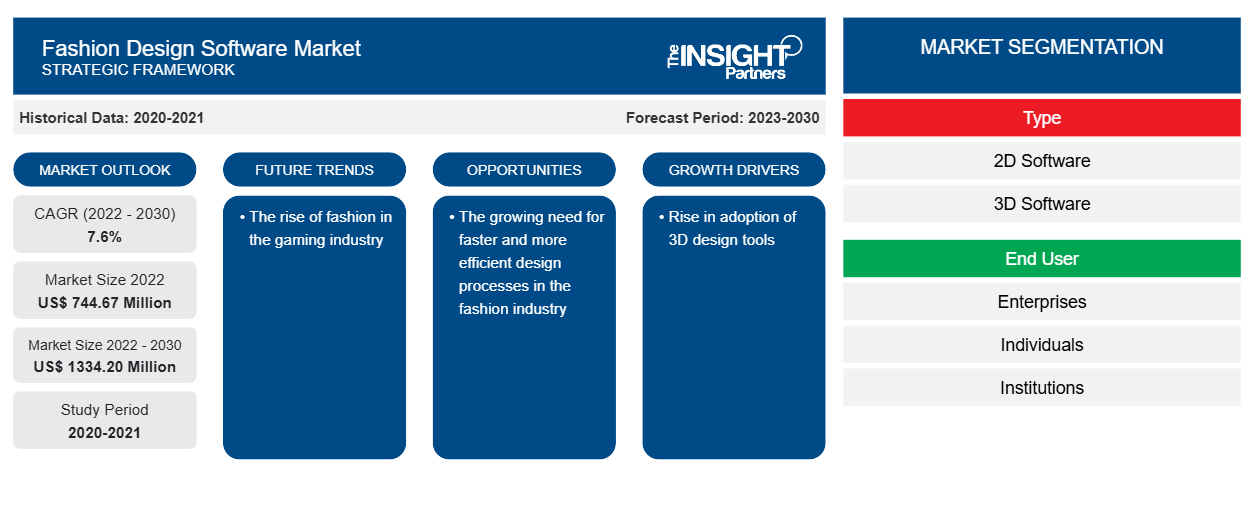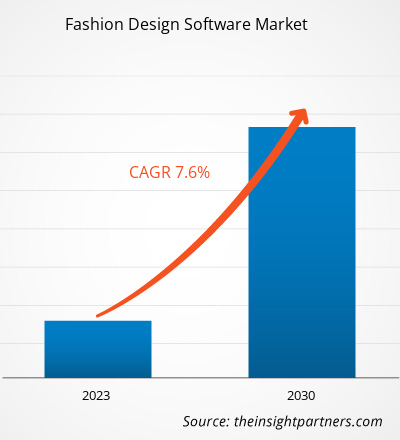The fashion design software market size is projected to reach US$ 1334.20 million by 2030 from US$ 744.67 million in 2022. The market is expected to register a CAGR of 7.6% during 2022–2030. A. The rise in adoption of 3D design tools and the growing need for faster and more efficient design processes in the fashion industry are likely to remain key trends in the market.
Fashion Design Software Market Analysis
One of the significant drivers for the fashion design software market is the growing trend of on-demand customization. With rising fashion awareness and a growing desire for individuality, consumers are seeking unique and personalized clothing items that reflect their personality and values. Fashion design software empowers designers to offer customization services, allowing buyers to preview and tailor their purchases according to their specific needs and preferences. Market players such as Amazon Fashion and Louoj have already launched virtual tools and 3D design customization software, catering to the demand for personalized fashion experiences. One of the key drivers is increasing the adoption of 3D design tools in the fashion industry. Fashion designers are turning to advanced CAD sketch tools such as Adobe Illustrator, Bluecherry, Browzwear, and C-Design Fashion to enhance their design processes significantly. These tools enable designers to create and visualize garments digitally, reducing the reliance on physical sampling and prototyping. The ability to explore multiple design variations and apply them to different materials and patterns streamlines the design process and leads to more innovative and unique designs.
Fashion Design Software Market Overview
The wide adoption of fashion design technology is transforming the way the apparel, fashion, and luxury (AF&L) industries use to design, develop, and market their products. The fashion design software streamlines the fashion design development process, lowering time and cost as well as environmental impact. The rising digitalization across the globe is leading to the adoption of fashion design software solutions.
Customize This Report To Suit Your Requirement
You will get customization on any report - free of charge - including parts of this report, or country-level analysis, Excel Data pack, as well as avail great offers and discounts for start-ups & universities
Fashion Design Software Market: Strategic Insights

-
Get Top Key Market Trends of this report.This FREE sample will include data analysis, ranging from market trends to estimates and forecasts.
Fashion Design Software Market Drivers and Opportunities
Fashion industry expansion
The fashion design software market growth is being driven by the increasing use of design tools and new technologies, as well as the industry's expansion efforts. In November 2022, CLO Virtual Fashion expanded to Paris, adding to its existing offices in Munich and Madrid. This step boosted the adoption of fashion design technology in the French fashion community and allowed for better support and services worldwide.
Growing adoption of software solution in the developing nations
Companies are adopting technologically advanced solutions and finding new ways to connect to their customers. For this, they are moving toward 3D. 3D is at the heart of so many technological advancements. 3D technology helps in the graphical representation of geometric data. The emergence of a wide range of apps has also enabled customers to try outfits on an avatar before the customer makes a purchase. This aids in quelling any doubts while buying something virtually. Fashion design software has also allowed for the creation of customized products, which is referred to as "fashion on demand." For a country like India, fashion has had varied connotations and purposes. Focusing on holistic education is expected to create students and designers who are ethical, aware, and can think out of the box to solve newer problems and issues that the coming times will bring with the help of the software.
Fashion Design Software Market Report Segmentation Analysis
Key segments that contributed to the derivation of the fashion design software market analysis are the type and end user.
- Based on the type, the fashion design software market is divided into 2D software and 3D software. The 3D segment is expected to grow with the highest CAGR.
- By end user, the market is segmented into enterprises, individuals, and institutions. The individuals segment is expected to grow with the highest CAGR.
Fashion Design Software Market Share Analysis by Geography
The geographic scope of the fashion design software market report is mainly divided into five regions: North America, Asia Pacific, Europe, Middle East & Africa, and South & Central America.
North America region held a significant market share. The region is home to many successful apparel design and manufacturing companies. The apparel business in the region has easily accepted new entrants, and there are hardly any barriers to entry concerning the government's policies. For instance, on March 7, 2022, Canada's Nextech signed multiple 3D model AR e-commerce deals. The Nextecha leading provider of augmented reality ("AR") experience technologies and services announced the signing of multiple 3D model AR e-commerce deals across several industries, including those new to Nextech, expanding the company's reach further into the e-commerce 3D modeling space.
Fashion Design Software Market Regional Insights
The regional trends and factors influencing the Fashion Design Software Market throughout the forecast period have been thoroughly explained by the analysts at The Insight Partners. This section also discusses Fashion Design Software Market segments and geography across North America, Europe, Asia Pacific, Middle East and Africa, and South and Central America.
Fashion Design Software Market Report Scope
| Report Attribute | Details |
|---|---|
| Market size in 2022 | US$ 744.67 Million |
| Market Size by 2030 | US$ 1334.20 Million |
| Global CAGR (2022 - 2030) | 7.6% |
| Historical Data | 2020-2021 |
| Forecast period | 2023-2030 |
| Segments Covered |
By Type
|
| Regions and Countries Covered |
North America
|
| Market leaders and key company profiles |
|
Fashion Design Software Market Players Density: Understanding Its Impact on Business Dynamics
The Fashion Design Software Market is growing rapidly, driven by increasing end-user demand due to factors such as evolving consumer preferences, technological advancements, and greater awareness of the product's benefits. As demand rises, businesses are expanding their offerings, innovating to meet consumer needs, and capitalizing on emerging trends, which further fuels market growth.

- Get the Fashion Design Software Market top key players overview
Fashion Design Software Market News and Recent Developments
The fashion design software market is evaluated by gathering qualitative and quantitative data post primary and secondary research, which includes important corporate publications, association data, and databases. A few of the developments in the fashion design software market are listed below:
- The Saudi Fashion Commission announced the launch of a new digital fashion design program in partnership with the prestigious Istituto Marangoni. The five-month program focused on teaching designers how to use the CLO 3D digital fashion design software, which allows for the creation of virtual, true-to-life garments and accessories. (Source: Al Arabiya Network, Press Release, January 2022)
Fashion Design Software Market Report Coverage and Deliverables
The "Fashion Design Software Market Size and Forecast (2020–2030)" report provides a detailed analysis of the market covering below areas:
- Fashion design software market size and forecast at global, regional, and country levels for all the key market segments covered under the scope
- Fashion design software market trends, as well as market dynamics such as drivers, restraints, and key opportunities
- Detailed PEST/Porter's Five Forces and SWOT analysis
- Fashion design software market analysis covering key market trends, global and regional framework, major players, regulations, and recent market developments
- Industry landscape and competition analysis covering market concentration, heat map analysis, prominent players, and recent developments for the fashion design software market
- Detailed company profiles
Frequently Asked Questions
What would be the estimated value of the fashion design software market by 2030?
Which are the leading players operating in the fashion design software market?
What is the future trend of the fashion design software market?
What is the expected CAGR of the fashion design software market?
What are the driving factors impacting the fashion design software market?
- Historical Analysis (2 Years), Base Year, Forecast (7 Years) with CAGR
- PEST and SWOT Analysis
- Market Size Value / Volume - Global, Regional, Country
- Industry and Competitive Landscape
- Excel Dataset
Recent Reports
Related Reports
Testimonials
Reason to Buy
- Informed Decision-Making
- Understanding Market Dynamics
- Competitive Analysis
- Identifying Emerging Markets
- Customer Insights
- Market Forecasts
- Risk Mitigation
- Boosting Operational Efficiency
- Strategic Planning
- Investment Justification
- Tracking Industry Innovations
- Aligning with Regulatory Trends





















 Get Free Sample For
Get Free Sample For